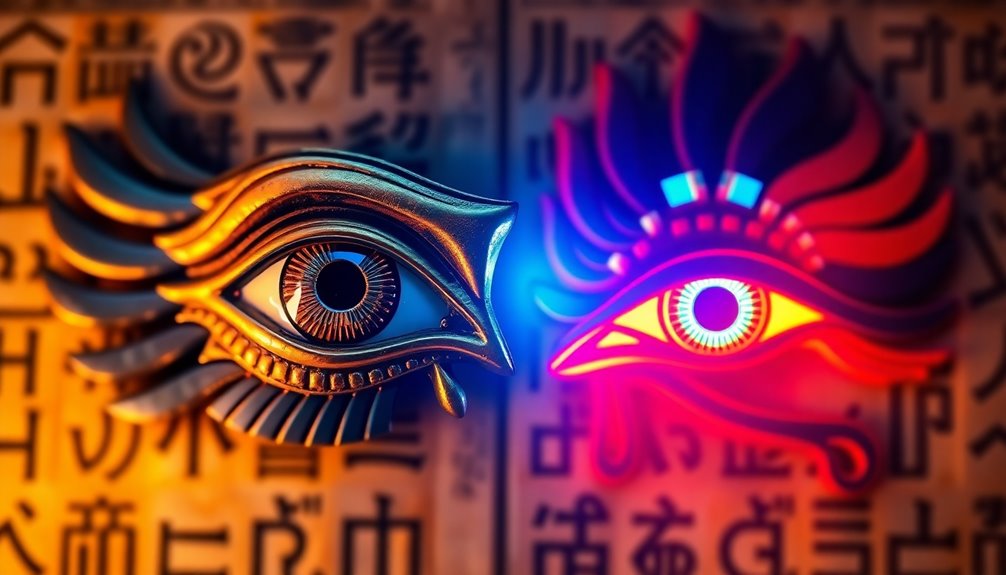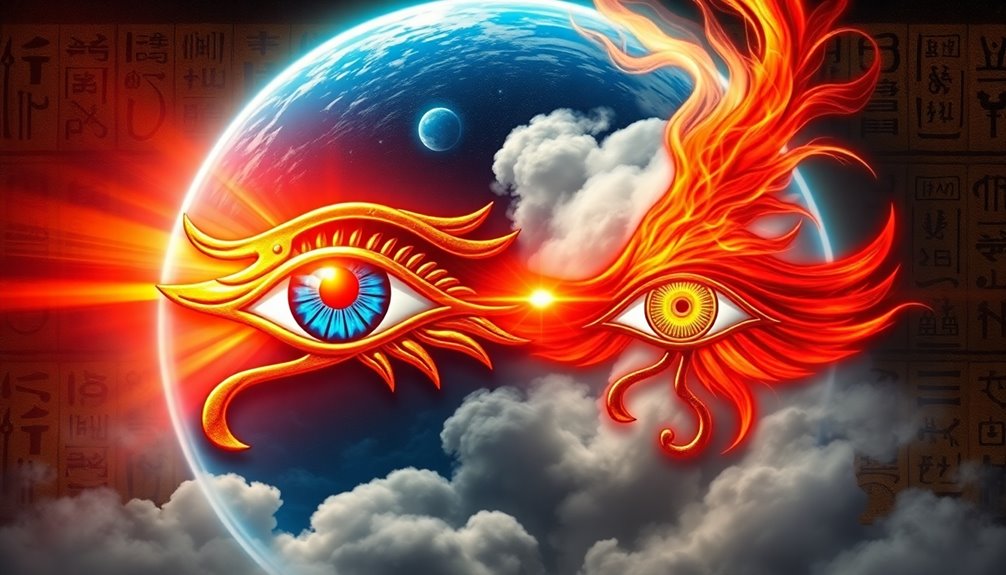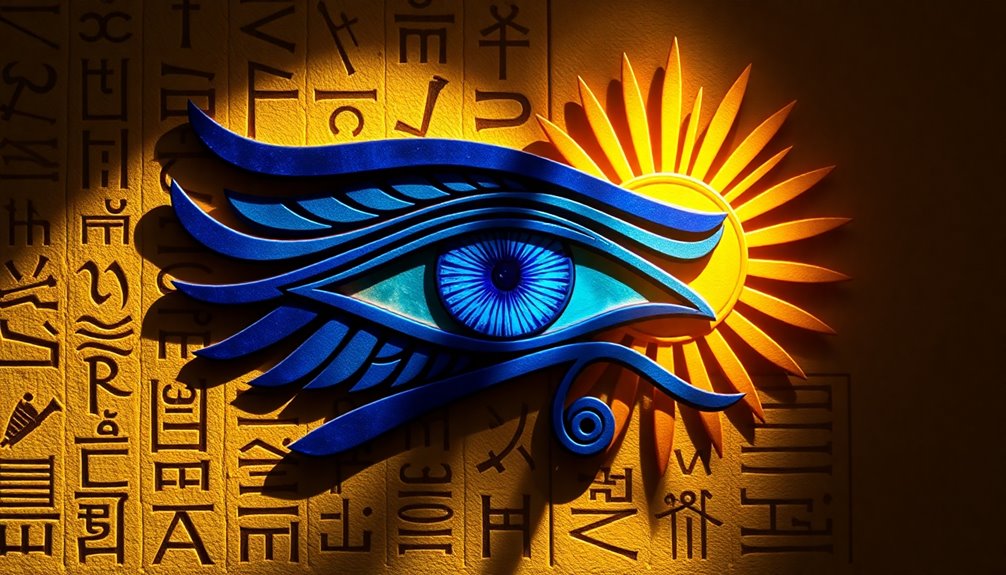The Eye of Horus and the Eye of Ra are fascinating symbols in ancient Egyptian mythology, each with distinct powers. The Eye of Horus represents healing, protection, and wisdom, linked to the moon and Horus's quest for vengeance. In contrast, the Eye of Ra symbolizes strength and punishment, associated with the sun god Ra and his fierce protection against disobedience. While Horus embodies compassion and restoration, Ra evokes a more aggressive force. Together, they showcase the balance between healing and vengeance in Egyptian spirituality. If you're curious about their deeper meanings and connections, there's so much more to uncover!
Key Takeaways
- The Eye of Horus symbolizes healing, protection, and wisdom, while the Eye of Ra represents power, punishment, and vengeance in Egyptian mythology.
- Both eyes are integral to ancient Egyptian culture, showcasing contrasting aspects of divine influence and balance in mythology.
- The Eye of Horus is linked to the moon and restoration, while the Eye of Ra is associated with the sun and maintaining order.
- Each symbol has evolved in modern culture, with the Eye of Horus representing well-being and the Eye of Ra signifying strength and consequences.
- Myths depict the Eye of Horus as a compassionate protector, while the Eye of Ra illustrates a more aggressive and punitive form of protection.
Background of Egyptian Eyes

The fascinating world of ancient Egyptian symbols reveals a deep connection to their deities, particularly through the Eyes of Horus and Ra. In ancient Egyptian culture, these eyes represent distinct yet intertwined concepts.
The Eye of Horus, associated with the moon, symbolizes healing, protection, and wisdom. It's often depicted as the left eye and used in art and jewelry as a protective amulet. You might find it fascinating how this symbol reflects the belief in safeguarding one's health and well-being.
In contrast, the Eye of Ra, linked to the sun, embodies power, fury, and punishment. This right eye signifies the strength of the sun and serves as a reminder of the consequences of disobedience in ancient mythology.
While both eyes can sometimes be referenced interchangeably, their meanings are rooted in specific myths surrounding Horus and Ra. Understanding this background enhances your appreciation for their cultural significance and the duality present in Egyptian mythology.
The Eye of Horus

The Eye of Horus represents powerful themes like healing and protection, rooted in ancient Egyptian mythology.
Its historical significance is tied to Horus's quest for vengeance and the restoration of his eye by Thoth, symbolizing wholeness.
Today, you'll find this emblem in various modern interpretations, from jewelry to spiritual practices, reflecting its lasting influence.
#
Symbolism and Meaning
In ancient Egyptian culture, the Eye of Horus holds profound symbolism and meaning, serving as a powerful emblem of protection and healing. This iconic symbol, often depicted as the left eye, is intricately tied to the mythology surrounding Horus avenging his father Osiris's death. Representing the moon, it reflects the cyclical nature of life, embodying rebirth and restoration.
The Eye of Horus is frequently used as a protective amulet against evil, showcasing its significance in daily life. Its design consists of several elements: the pupil symbolizes protection and healing, while the teardrop represents the grief and sacrifice for Osiris.
Often referred to as the "all-seeing eye," it embodies vigilance and moral clarity, making it a cornerstone of ancient Egyptian belief systems.
Additionally, the six distinct pieces of the Eye of Horus symbolize the senses, highlighting its multifaceted significance in ancient medicine and dye measurement. In this way, the Eye of Horus transcends mere decoration; it serves as a potent reminder of the interconnectedness of life, protection, and healing within ancient Egyptian culture.
Historical Significance
Rooted deeply in ancient Egyptian mythology, the Eye of Horus, or Wedjat, symbolizes not just protection and healing but also embodies the resilience of life itself. This powerful emblem originates from the myth of Horus avenging his father Osiris's death. In this tale, Horus loses his eye during a battle against Set, only to have it restored by the god Thoth, emphasizing themes of wholeness and regeneration.
The historical significance of the Eye of Horus extends beyond mythology. It served as a protective amulet, believed to ward off evil and bring fortune. In ancient Egyptian civilization, its six parts represented the senses and were utilized in medical practices, showcasing the blend of healing and spirituality.
| Symbol | Meaning | Usage |
|---|---|---|
| Eye of Horus | Protection & Healing | Amulets for safety |
| Eye of Ra | Sun's power | Protection against chaos |
| Wedjat | Wholeness | Medical measurement tool |
| Horus | Resurrection | Symbol of royal authority |
| Thoth | Wisdom | Knowledge and writing |
This enduring legacy of the Eye of Horus continues to resonate, reflecting its cultural significance throughout history.
Modern Interpretations
Throughout the ages, the Eye of Horus has evolved from an ancient symbol of protection and healing into a vibrant part of modern culture.
Today, you'll find the Eye of Horus prominently featured in modern jewelry, often crafted as talismans believed to ward off evil and promote good health. This symbol's cultural significance continues to thrive, making its way into the works of contemporary artists like Salvador Dali and Pablo Picasso, who highlight its aesthetic appeal.
In fashion, designers such as Alexander McQueen have embraced the Eye of Horus, incorporating its imagery to evoke themes of ancient mystique and spiritual protection.
Its allure even extends into New Age practices, where it's associated with enhancing psychic abilities and divination, bridging the gap between ancient Egyptian mythology and modern spiritualism.
The Eye of Horus isn't just restricted to art and fashion; it has become a recognizable emblem in films and video games like "The Mummy" and "Assassin's Creed," serving as a protective symbol against malevolent forces.
With each interpretation, the Eye of Horus continues to resonate, proving its enduring legacy in contemporary culture.
The Eye of Ra

The Eye of Ra serves as a powerful symbol of protection and vengeance in Egyptian mythology, reflecting the sun god Ra's fierce nature.
You'll find that myths surrounding this eye highlight its role in punishing disobedience and maintaining order.
Today, the Eye of Ra continues to carry cultural significance, representing both strength and the consequences of one's actions.
Symbolism of Protection
When you think of protection in ancient Egyptian mythology, the Eye of Ra stands out as a powerful symbol. This eye, associated with Ra's daughter, embodies the sun's fierce nature and protective power. Unlike the Eye of Horus, which often symbolizes healing and restoration, the Eye of Ra represents a more aggressive form of protection. It acts as a weapon of vengeance against those who disrespect Ra, emphasizing its role in punishment as well as safeguarding the divine order.
The mythology surrounding the Eye of Ra includes tales of Ra transforming his daughter into a lioness to enact retribution, showcasing the eye's dual role in both protection and punishment. This fierce representation instills fear and guarantees obedience among followers, reinforcing its significance in ancient Egyptian culture.
While the Eye of Ra symbolizes violence, it also reflects the life-giving power of the sun, illustrating the complexity of its protective significance. The goddess Wadjet, often linked to the Eye, further enhances its protective qualities, weaving a narrative that intertwines vengeance with the nurturing aspects of the sun.
This multifaceted symbol continues to captivate those interested in ancient Egyptian mythology.
#
Myths and Legends
Many fascinating myths and legends surround the Eye of Ra, each revealing its powerful presence in ancient Egyptian culture. Unlike the Eye of Horus, known for its healing and protective force, the Eye of Ra embodies a more destructive power. Created by the goddess Hathor, it serves as a weapon to punish disobedient humans, reflecting Ra's fierce commitment to maintaining cosmic order.
Ra's daughter, Sekhmet, symbolizes the Eye of Ra, releasing vengeance on humanity when provoked. This showcases the eye's association with fury and power. In an effort to calm her wrath and prevent further chaos, Ra once intoxicated Sekhmet with beer, illustrating the dual nature of the Eye of Ra as both a protective force and a source of turmoil.
The Eye of Ra stands as a sentinel against threats, embodying the sun's scorching might and relentless judgment. While it punishes those who stray from the path of righteousness, it simultaneously reinforces the balance of the universe.
Through these myths, you can see how the Eye of Ra plays an essential role in Egyptian mythology, contrasting sharply with the benevolent nature of the Eye of Horus.
#
Cultural Significance
Today
Exploring the myths surrounding the Eye of Ra reveals its lasting impact on modern culture. This powerful symbol, often linked to the fierce protective nature of Ra's daughter, embodies the consequences of one's actions in ancient Egyptian belief.
Today, the Eye of Ra is a popular motif in art and jewelry, representing not only strength and protection but also the delicate balance between creation and destruction.
You might notice the Eye of Ra depicted as a sun disk encircled by a serpent or accompanied by a lioness, showcasing its dual protective and vengeful aspects. Its cultural significance extends beyond mere aesthetics; it's embraced in contemporary spiritual practices for its associations with power, wisdom, and transformative forces of nature.
Additionally, the Eye of Ra finds its place in modern branding and marketing, signifying authority and vigilance. By drawing on its historical significance, brands utilize the Eye of Ra to convey trust and strength, much like the way the Eye of Horus represents protection.
Key Differences

The Eye of Horus and the Eye of Ra are two powerful symbols from ancient Egyptian mythology, each carrying distinct meanings and representations.
The Eye of Horus, depicted as the left eye, is a potent symbol of healing, protection, and restoration. This symbol features falcon-like markings and serves as a protective amulet, linked to health and well-being.
In contrast, the Eye of Ra, represented as the right eye, embodies power, fury, and destruction. Often illustrated as a sun disk accompanied by a cobra or lioness, it symbolizes the fierce consequences of disrespect towards the gods.
In mythology, these eyes tell contrasting stories: the Eye of Horus is associated with Horus avenging Osiris's death, while the Eye of Ra involves Ra's daughter punishing disobedient followers.
Both symbols appear in ancient Egyptian art and jewelry, yet they convey opposing meanings. The Eye of Horus is viewed positively, promoting safety and healing, whereas the Eye of Ra carries a darker protective force, often regarded negatively.
Understanding these key differences enhances your appreciation of their unique roles within Egyptian mythology.
## Symbolism and Meaning

Understanding the unique symbolism of the Eye of Horus and the Eye of Ra enriches your grasp of their meanings in ancient Egyptian culture.
The Eye of Horus, representing the god Horus, embodies protection, healing, and restoration. Linked to the myth of Horus avenging his father Osiris, this symbol often signifies safety against evil forces. You can visualize it as the left eye, marked with falcon-like features, emphasizing its connection to the moon and healing.
In contrast, the Eye of Ra is associated with the sun god, symbolizing power, fury, and vengeance. This eye is depicted as the right eye and often represented by a sun disk with a cobra or lioness. While the Eye of Horus protects, the Eye of Ra instills fear in those who disobey, showcasing its role in punishment.
Both symbols play significant roles in ancient Egyptian mythology, complementing each other. While the Eye of Horus focuses on safeguarding and restoration, the Eye of Ra emphasizes the destructive force of the sun, highlighting their distinct yet interconnected meanings within the rich tapestry of ancient Egyptian beliefs.
## Cultural Significance

Frequently, the Eye of Horus and the Eye of Ra emerge as powerful symbols in ancient Egyptian culture, each carrying deep cultural significance. The Eye of Horus represents healing and protection, often used as a protective amulet to safeguard against evil influences. Its significance in ancient Egyptian society reflects a belief in divine intervention, where the eye was thought to guarantee health and good fortune.
In contrast, the Eye of Ra embodies power and vengeance. Associated with the sun god Ra, it symbolizes his role in punishing disobedient followers, highlighting a darker aspect of protection. This duality illustrates the complexity of ancient Egyptian mythology, where both eyes play vital roles in the cultural narrative.
You'll find that the Eye of Horus is linked to Horus avenging his father, Osiris, emphasizing restoration and royal authority. Meanwhile, the Eye of Ra signifies the sun's destructive force, reinforcing the consequences of disobedience.
Together, these symbols represent the intricate balance of protection and power within ancient Egyptian beliefs, reflecting both the hope for healing and the fear of retribution.
## Myths and Legends

In ancient Egyptian mythology, the Eye of Horus and the Eye of Ra each have enchanting stories that reveal their significance.
The Eye of Horus symbolizes healing and protection, rooted in the myth of Horus avenging his father, Osiris. During his battle against Set, Horus loses his eye, which Thoth later restores. This tale emphasizes the themes of restoration and compassion, showcasing Horus as a symbol of wholeness in ancient Egypt.
On the other hand, the Eye of Ra, associated with the sun god Ra, embodies vengeance and power. Created by Hathor, this protective weapon punishes humanity when Ra becomes enraged.
One fascinating myth tells of Ra getting intoxicated to prevent his daughter, who represents the Eye, from releasing her wrath upon mankind. This story illustrates the dual nature of Ra's eye, embodying both the destructive force of the sun and the repercussions of disobedience.
Ultimately, the myths surrounding these two eyes highlight their unique attributes: the Eye of Horus stands for healing and protection, while the Eye of Ra represents strength and punishment, making them powerful symbols in ancient Egyptian mythology.
Frequently Asked Questions
How to Tell the Difference Between the Eye of Horus and the Eye of Ra?
To tell the difference between the Eye of Horus and the Eye of Ra, look closely at their shapes and symbols.
The Eye of Horus has a teardrop shape and is often associated with healing and protection.
In contrast, the Eye of Ra appears more aggressive, usually depicted with a sun disk and a lioness or serpent.
What Religion Believes in the Eye of Ra?
Did you know that ancient Egyptian religion was practiced for over 3,000 years?
In this fascinating belief system, you'll find the Eye of Ra, a powerful symbol associated with the sun god Ra. Egyptians believed in Ra's protective and punishing nature, invoking the Eye during rituals for strength and safety.
While the religion isn't practiced today, its influence lingers in modern spiritual practices, highlighting the enduring power of symbols like the Eye of Ra.
What Is the Deeper Meaning of the Eye of Horus?
The Eye of Horus represents protection, healing, and wholeness. When you look at it, you see a symbol rooted in the myth of Horus avenging his father. Its falcon-like markings remind you of the moon's cyclical nature, emphasizing rejuvenation.
Each of its six parts corresponds to your senses, enhancing its significance. By wearing or displaying it, you invite good fortune and ward off evil, connecting you to ancient beliefs of divine safeguarding.
Is the Eye of Horus Masculine or Feminine?
You might find the Eye of Horus embodies masculine traits, representing strength and protection associated with the god Horus.
However, its healing and restorative qualities also connect to nurturing aspects often linked to femininity.
This duality shows that while the Eye of Horus is primarily masculine, its symbolism resonates universally, transcending gender boundaries.
Conclusion
In the grand tapestry of ancient Egypt, the Eye of Horus and the Eye of Ra stand as powerful symbols, each with their own story to tell. As you explore deeper into their meanings, you might just find echoes of Osiris and Isis in your own life—protection, healing, and divine insight. So, the next time you encounter these iconic eyes, remember: they're not just artifacts; they're windows into the soul of a civilization that still captivates us today.










